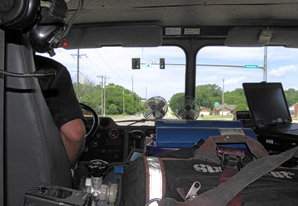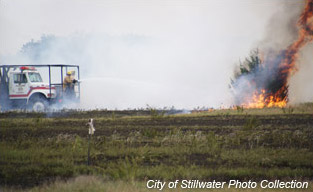July 26, 2013 – The core function of the EMTRAC system is to help reduce response times for first responders by enabling their vehicles to automatically request priority through upcoming intersections. However, first-response agencies that use the system often find their own ways to utilize the flexibility that it offers—all in an effort to meet their own goals for improved safety and performance.

One such agency is the Stillwater Fire Department (SFD) in Stillwater, Oklahoma. The SFD response area includes a unique combination of surroundings. In addition to residential, business, and manufacturing areas, the SFD response area includes a major university (Oklahoma State University) that expands the population on an annual basis, as well as vast rural areas that are prone to brush fires throughout the summer.

“Stillwater has used traffic control preemption devices for at least the last 20 years. On a college football weekend there is huge influx of visitors, so being able to have that little extra help in clearing controlled intersections provides huge safety dividends for our emergency responders and the public,” says Chief Tom Bradley.
“Stillwater is a regional hub of commercial activity with a major university, so all of this activity creates dynamic traffic conditions.” adds Chief Bradley, who has been with the Stillwater Fire Department since 1984.
In their continuing effort to ensure public safety, the Stillwater Fire Department has some key factors working in its favor:
- Major thoroughfares that cover large portions of the city, enabling SFD vehicles to avoid excessive turns and side streets when on call.
- Extensive use of traffic signal priority at intersections along major thoroughfares, significantly reducing travel time by providing a green signal in advance of the fire vehicles reaching the intersection (while stopping conflicting traffic to further help clear the intersection).
- A fire department focused on rapid response and personal safety to ensure that technological advantages result in measurable gains—protecting and preserving lives and property in Stillwater and surrounding communities.
- A progressive city administration that recognizes the value of using technology to its advantage. In Stillwater’s case, multiple departments collaborated to facilitate the installation—including city government, the Fire Department, the Transportation Department, and the IT department. Because of this teamwork, the Stillwater Fire Department has an advanced traffic preemption system that allows them to gather and analyze response data while also enhancing department safety as well as the safety of the motoring public.
“As the first-generation devices began to have issues including increased maintenance and reliability, we began to explore systems that could provide a greater number of options while providing a high degree of enhanced safety for our apparatus making emergency responses,” Chief Bradley said. “I have been very pleased with the high degree of reliability and the increase in the confidence with our system that we now enjoy.”
An example of Stillwater’s progressive approach was demonstrated by their desire to implement anti-collision functionality, which was provided by the Collision Avoidance feature of the EMTRAC system. This feature triggers an audio alert to notify drivers when equipped vehicles are approaching each other and there is potential for collision.

The Collision Avoidance functionality was initially developed with the idea that it would be used mainly in urban environments, where many first-response vehicles often respond to the same call. For Stillwater, however, the occurrence of brush fires present prime conditions for collisions due to lack of visibility, particularly when multiple trucks are on location. Because of these brush fires, anti-collision capability was specifically addressed in Stillwater’s requirements for traffic-signal preemption.
According to Chief Bradley, “This system has capabilities beyond just responding to emergency incidents. We can collect and analyze data to ensure we are providing safe and effective delivery of emergency services to our community.”
Bradley adds, “This project would never have been started much less completed without the support of our Mayor and City Council.”
